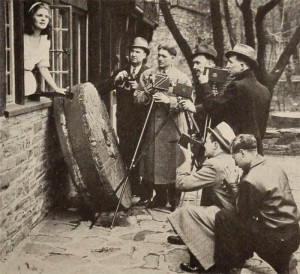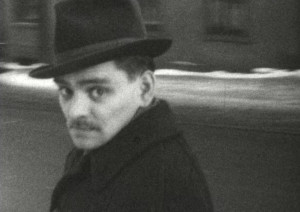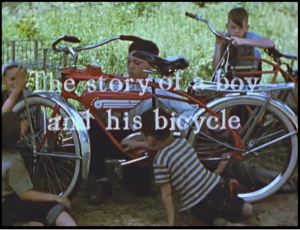
An amateur club adaptation of Alfred Noyes poem The Highwayman. A "ballad of love and murder" that "emphasizes atmosphere and explores the sympathetic relationship between natural and dramatic elements". The poem "narrates the highwayman's secret meeting with his love Bess, a landlord's daughter, their discovery by a group of soldiers who hold Bess as bait for the highwayman, and her grisly death by musket...Throughout the poem the natural settings play an important role in amplifying its supernatural and dramatic content...Like its use of natural settings, a natural acting style was employed to set this film adaptation apart from its source materials and its rival media. Finally, the film's use of double exposure in order to create the impression of ghostliness in the tragic couple's final reunion marks a particularly cinematic solution to the problem of visual representation" Tepperman, 244-245. Title credits name Tedd Briggs as the director and Alan Moorhouse as the Producer, "under the auspices of the Toronto Amateur Movie Club".

C’est à l’automne 1937, au retour de l’exposition universelle de Paris, qu’Omer Parent entreprend la réalisation de l’œuvre expérimentale La vie d’Émile Lazo. En réaction directe à la « loi du cadenas » émise par le gouvernement Duplessis, le titre de ce court-métrage réfère au tout premier film visé par cette nouvelle motion censurogène, imposée aux médias : The life of Emile Zola de William Dieterle (1937).
S’il s’agit là du premier film expérimental achevé par Parent, l’œuvre est également issue d’une collaboration amicale au sein de professeurs de l’École des beaux-arts de Québec qui se prêtent au jeu de l’acteur : la sculptrice Sylvia d’Aoust (1902-2004), la dessinatrice Arline Généreux (1897-1987), la graveuse Simone Hudon (1905-1984), le couple Madeleine Des Rosiers (1904-1994) et son mari Jean Paul Lemieux (1904-1990), tous les deux peintres. À cette petite bande — qui fréquente l’éphémère atelier du « Nordet » où le tournage a lieu —, s’ajoute Robert Lapalme (1908-1997), caricaturiste et illustrateur de talent au style immédiatement reconnaissable, seule figure à ne pas occuper alors un poste de professeur. Sorte d’électron libre, Lapalme, en plus de rédiger le scénario du film en écho à sa propre existence, y incarne le rôle d’Émile Lazo. Terminé au printemps 1938, ce film « amateur » porte sur la condition de l’artiste « moderne » vis-à-vis de l’académisme dont il cherche à se libérer.
Peu après sa création, La vie d’Émile Lazo a été projetée à quelques reprises lors de présentations publiques et particulières dont une visait, en 1941, à célébrer l’installation d’Alfred Pellan — meilleur ami de Parent — dans son nouvel atelier. Depuis cette époque, ce film, dont il n’existe que deux copies sur pellicule, est demeuré pour ainsi dire inédit, connu seulement par quelques amateurs et spécialistes. Zoom-out est fier de présenter cette satire, rare et burlesque.
In the autumn of 1937, upon his return from the Paris Universal Exhibition, Omer Parent undertakes the creation of the experimental work "The Life of Emile Lazo". In direct reaction to the "Padlock Law" issued by the Duplessis government, the title of this short movie refers to the very first film targeted by this new censorship motion imposed on the media: William Dieterle's "The Life of Emile Zola" (1937). Completed in the spring of 1938, this "amateur" movie deals with the condition of the "modern" artist in relation to academicism from which he seeks to free himself.
While this is Parent's first experimental work, it is also the result of a friendly collaboration among professors at the École des beaux-arts de Québec who lend themselves to the role of actors: sculptor Sylvia d'Aoust (1902-2004), draughtswoman Arline Généreux (1897-1987), engraver Simone Hudon (1905-1984), the couple Madeleine Des Rosiers (1904-1994) and her husband Jean Paul Lemieux (1904-1990), both painters. A little appart in this small group of artists and professors — who frequents the ephemeral "Nordet" studio where filming takes place— Robert Lapalme (1908-1997), a talented caricaturist and illustrator with a immediately recognizable style, is added. Lapalme, in addition to writing the film's screenplay in echo with his own existence, also plays the role of Émile Lazo.
Shortly after its creation, "The Life of Émile Lazo" was screened a few times during public and private presentations, one of which aimed, in 1941, to celebrate the installation of Alfred Pellan—Parent's best friend—in his new studio. Since then, this rare and burlesque satire, of which only two copies on film exist, has remained virtually unpublished, known only to a few enthusiasts and specialists until fall of 2022 where it was realeased online.
Film documentario/Documentary
"...film che offre una rapida visione del primi anni di vita delle nuove generazioni, cui appunto è affidato il domani della Nazione"—"I Littoriali del cinema: i documentari della prima giornata," La Stampa, September 2, 1939
"...film that offers a rapid vision of the first years of life of the new generations, to whom precisely is entrusted the tomorrow of the Nation." —"I Littoriali del cinema: i documentari della prima giornata," La Stampa, September 2, 1939
"The tranquil countryside of east Lancashire belies its sometimes turbulent history, and Pendle Hill, overlooking the area, is to this day associated with the infamous witch trials of 1612. In this short colour film by amateur filmmaker Kenneth Prior, we visit the locations of the notorious events, in a county that saw more of an upsurge in supposed witchcraft activity than any other in the north." (BFI Player)
"Tales of doomed and thwarted love are timeless, and this intriguing short film relates a story set in Imperial China. Told to a young couple planning their wedding and marital home, they - and we - learn the tragic tale of Koong-Shee and Chang, her father's servant, as revealed in the traditional pattern on a Willow pattern plate. George Wain, one of the filmmakers, plays the role of the fiancé." (BFI Player)

"An experimental film about a boy owning a bicycle and learning the proper safety rules on the road." Wisconsin Center for Film and Theater Research
"Filmed in 1939 by the town doctor, Cologne is a personalized portrait of a farming community that merited only a single sentence in the WPA’s 1938 guidebook to Minnesota: “COLOGNE (945 alt., 355 pop.) is a German community named for the ancient city on the Rhine.” Dr. Raymond Dowidat and his wife, Esther, arrived in 1937 for his first practice after internship, and the impulse for the film seems to have arisen from their desire to document Cologne before they moved on to his next position in Minneapolis." filmpreservation.org
Fragment of a documentary
"documenta l'attività invernale del Guf di Roma a Bardonecchia e di Littoriali della neve colà svoltisi." [documents the winter activities of the Guf of Rome in Bardonecchia and of the Littoriali della neve there.]
Total Pages: 299